

Forty years ago, in January 1960, the X-15-1, 56-6670 had returned to Edwards Air Force Base after the installation of its pair of Reaction Motors XLR-11 engines. It had been carried on four captive flights before it made a single glide flight on June 8, 1959.
The X-15-2, 56-6671 was at North American Aviation in El Segundo for repairs following the engine explosion and structural failure that it suffered on mission 2-3-9* on November 5, 1959. On its three flights, it had reached a maximum speed of Mach 2.15 and a maximum altitude of 61,781 feet. Scott Crossfield had been the sole X-15 pilot during the contractor demonstration phase.
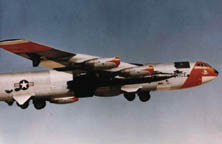 The NB-52A takes off with the
X-15-1 on one of the first three captive carry flights in March
and April, 1959. The first flight on March 10 was an intentional
captive flight. Subsequent flights on April first and tenth were
aborted attempts at a glide flight. On flight 1-A-3, the
unexpected high intensity noise produced by the turbulence in the
notch in the trailing edge of the NB-52A's wing cracked the skin
of the upper rudder of the X-15. The dayglo orange paint adorning
the nose of the NB-52A can be seen to extend around the bottom of
the fuselage. The badge of the Air Research and Development
Command (ARDC) has been applied to the side of the fuselage,
below the cockpit. Only the flaps on this side of the NB-52A are painted white. Photo courtesy: AFFTC/HO.
The NB-52A takes off with the
X-15-1 on one of the first three captive carry flights in March
and April, 1959. The first flight on March 10 was an intentional
captive flight. Subsequent flights on April first and tenth were
aborted attempts at a glide flight. On flight 1-A-3, the
unexpected high intensity noise produced by the turbulence in the
notch in the trailing edge of the NB-52A's wing cracked the skin
of the upper rudder of the X-15. The dayglo orange paint adorning
the nose of the NB-52A can be seen to extend around the bottom of
the fuselage. The badge of the Air Research and Development
Command (ARDC) has been applied to the side of the fuselage,
below the cockpit. Only the flaps on this side of the NB-52A are painted white. Photo courtesy: AFFTC/HO.
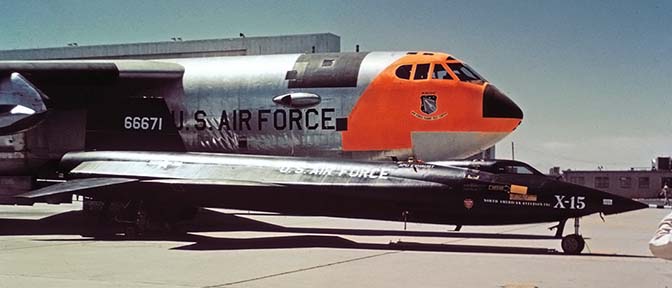 The North American X-15-2 made
its first public appearance at the Edwards Air Force Base Open
House and Airshow Display, held on May 19, 1959. It was posed
with the NB-52A, 52-0003. The X-15-2 was delivered with only one
VHF antenna on the lower fuselage. Later in the program a second
VHF antenna would be added. Go to more photos of the 1959 Edwards AFB Airshow. Photo by Richard
Lockett Sr.
The North American X-15-2 made
its first public appearance at the Edwards Air Force Base Open
House and Airshow Display, held on May 19, 1959. It was posed
with the NB-52A, 52-0003. The X-15-2 was delivered with only one
VHF antenna on the lower fuselage. Later in the program a second
VHF antenna would be added. Go to more photos of the 1959 Edwards AFB Airshow. Photo by Richard
Lockett Sr.
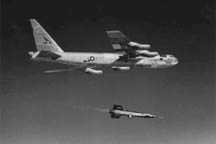 The X-15-1
with Scott Crossfield at the controls was launched from the
NB-52A on its first flight on June 8, 1959. Charles Bock and
Major Jack Allavie were piloting the NB-52A. This was the only
intentional glide flight of the X-15 program. Photo courtesy Air
Force Flight Test Center History Office.
The X-15-1
with Scott Crossfield at the controls was launched from the
NB-52A on its first flight on June 8, 1959. Charles Bock and
Major Jack Allavie were piloting the NB-52A. This was the only
intentional glide flight of the X-15 program. Photo courtesy Air
Force Flight Test Center History Office.
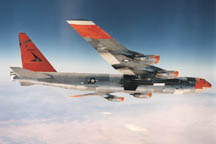 The X-15-2
being carried by the NB-52A in October or November 1959. Scott
Crossfield is in the cockpit of the X-15. Jack Allavie and either
Charles Bock or Fitzhugh Fulton are aboard the NB-52A. The X-15
mission mark visible next to the astrodome represents mission
2-A-4, an aborted launch attempt flown on October 10, 1959. Photo
courtesy Air Force Flight Test Center History Office.
The X-15-2
being carried by the NB-52A in October or November 1959. Scott
Crossfield is in the cockpit of the X-15. Jack Allavie and either
Charles Bock or Fitzhugh Fulton are aboard the NB-52A. The X-15
mission mark visible next to the astrodome represents mission
2-A-4, an aborted launch attempt flown on October 10, 1959. Photo
courtesy Air Force Flight Test Center History Office.
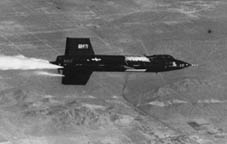 On November 5, 1959, the third
flight of the X-15-2 was cut short by an explosion in one of the
combustion chambers of the lower XLR-11 rocket engine 13.9
seconds after ignition of the first chamber. The X-15 is seen
here jettisoning propellants with
the town of Rosamond in the background. Scott Crossfield landed
the X-15 on Rosamond Dry Lakebed on the west end of the Air Force
Base. He was unable to jettison all of the propellants and landed
heavy. Photo courtesy Air Force Flight Test Center History
Office.
On November 5, 1959, the third
flight of the X-15-2 was cut short by an explosion in one of the
combustion chambers of the lower XLR-11 rocket engine 13.9
seconds after ignition of the first chamber. The X-15 is seen
here jettisoning propellants with
the town of Rosamond in the background. Scott Crossfield landed
the X-15 on Rosamond Dry Lakebed on the west end of the Air Force
Base. He was unable to jettison all of the propellants and landed
heavy. Photo courtesy Air Force Flight Test Center History
Office.
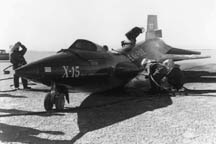 The X-15-2 on Rosamond Dry Lake
following mission 2-3-9*. The fuselage
failed when the nose gear impacted the ground. The shock
absorbing ability of the front landing gear strut was impaired by
foaming of the oil in the strut when it was extended. The back of
the X-15 broke at a structural join behind the cockpit. It was
trucked back to Los Angeles for repairs. Photo E-9543 courtesy
NASA Dryden.
The X-15-2 on Rosamond Dry Lake
following mission 2-3-9*. The fuselage
failed when the nose gear impacted the ground. The shock
absorbing ability of the front landing gear strut was impaired by
foaming of the oil in the strut when it was extended. The back of
the X-15 broke at a structural join behind the cockpit. It was
trucked back to Los Angeles for repairs. Photo E-9543 courtesy
NASA Dryden.
B-52B, 52-0008 had joined the X-15 program in November 1959 and carried the designation NB-52B. It carried the X-15-1 for the first time on December 16, 1959. The first attempt to make a powered flight in the X-15-1 was aborted five seconds before launch due to a radio malfunction.
The first powered flight of the X-15-1 was launched on January 23, 1960. Fitzhugh Fulton and Charles Kuyk launched Scott Crossfield from the NB-52B on mission 1-2-7*. Crossfield reached a speed of Mach 2.53 and an altitude of 66,844 feet during 4 minutes and 27 seconds of rocket-powered flight. The only pilots to have flown faster were Pete Everest, Ivan Kinchloe, and Mel Apt in the X-2 in 1956.
 Books about
the X-15 available from
Books about
the X-15 available from 
 Angle of Attack : Harrison Storms and the Race to
the Moon by Mike Gray. The biography of Harrison Storms, who
was instrumental in the development and operation of the X-15.
Angle of Attack : Harrison Storms and the Race to
the Moon by Mike Gray. The biography of Harrison Storms, who
was instrumental in the development and operation of the X-15.
 At the Edge of Space : The X-15 Flight Program
by Milton O. Thompson. The story of test flying the X-15 from the
point of view of the pilot.
At the Edge of Space : The X-15 Flight Program
by Milton O. Thompson. The story of test flying the X-15 from the
point of view of the pilot.
*The first position of the mission number identifies which X-15 was involved, the second number indicates how many times that X-15 had been launched, and the third number indicates how many times it had been carried by an NB-52.
Send a message to Brian
Go to home page of the Goleta Air & Space Museum.